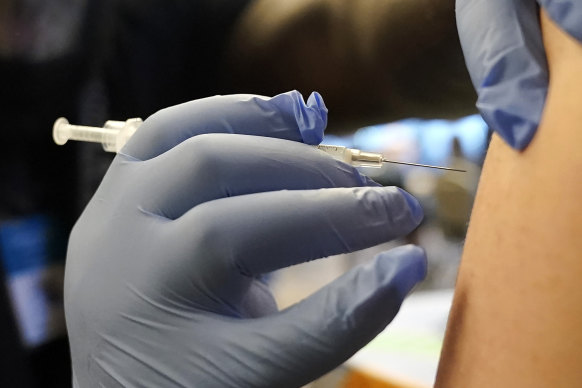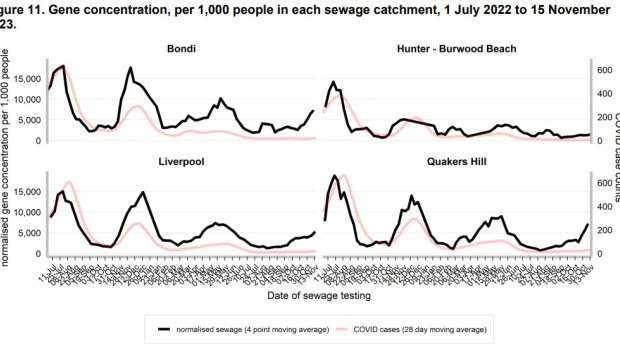Save articles for later
Add articles to your saved list and come back to them any time.
Children and young adults are driving a surge in people presenting to emergency departments with COVID-19 as infection rates continue to climb across NSW in the run-up to the Christmas break.
The surge in infections is prompting fresh calls for vulnerable people to seek booster shots, weeks after new monovalent vaccines targeted at sub-variants of the Omicron strain became available.
Vulnerable people are being urged to seek their booster shot. Credit: AP
NSW Health said emergency departments presentations for COVID-19 had continued to increase in the past fortnight, particularly in young children, and in people aged 17 to 34.
The latest NSW Health data showed 812 COVID-positive people went to emergency departments in the week to December 17, up from 721 and 628 in the previous two weeks.
“Community transmission of COVID-19 in NSW has increased and is at high levels,” a spokeswoman said.
NSW recorded 6210 positive PCR tests in the two weeks to December 16, up from 5333 in the previous fortnight. The latest sewage testing data also indicates the concentration of COVID-19 in Bondi, Liverpool and Quakers Hill has risen since the last fortnightly results were released.
The EG.5 variant accounts for most cases across the state, but the proportion of samples in which BA.2.86 and the new JN.1 variants have been detected has risen sharply since the end of November.
The World Health Organisation this week declared the emerging JN.1 a “variant of interest”, saying it was spreading rapidly across the globe but currently posed a low additional public health risk.
Associate Professor Stuart Turville, a virologist at the Kirby Institute, said the JN.1 subvariant, which had evolved from the Omicron BA.2.86 variant, was expected to take over from the XBB subvariants as the dominant strain in 2024.
“The way JN.1’s getting into cells is far more competitive and that’s probably the key factor that’s driving the rates of transmission and infection in the Northern Hemisphere at the moment,” Turville said.
NSW Health said COVID infections in children and young people were driving the wave of infections in NSW.Credit: NSW Health
Turville said the fast-spreading virus could trigger a “double hump” in COVID-19 infections.
“I think we thought we’d get around Christmas and be over the wave of the back end of the XBB [variants], but there might be a little bit of a follow-on as JN.1 enters the community.
“It is very competitive if you look at the numbers compared to the other variants, its growth advantage is very, very high.”
The new monovalent – or “XBB.1.5-containing” – vaccines have been available to eligible Australians since December 1 following approval by the Australian Technical Advisory Group on Immunisation (ATAGI).
The vaccines targeting a sub-variant of the Omicron strain have been approved for use as both primary and additional doses, with Pfizer’s version approved for eligible people aged over five years, and Moderna’s for those over 12.
The vaccines offer modestly improved protection against COVID-19 strains circulating in Australia, the federal government said in a statement.
It did not recommend extra doses of the new jab for healthy people under 65 who already had their recommended 2023 dose of a COVID vaccine.
But it encouraged recommended groups – those over 75, and younger people with medical comorbidities – who had not been vaccinated this year to get one as soon as possible, given there had been a rise in COVID cases across Australia in November.
Pharmacy Guild NSW branch president David Heffernan said vaccination rates had broadly dropped, but he encouraged vulnerable people – including the elderly, immunocompromised and Indigenous Australians – to get their booster shot to minimise their risk during the holidays.
“The vulnerable populations are still vulnerable. The message to those populations is, make sure you’re vaccinated.”
Turville said the updated vaccines would help “future-proof” the recipient’s immune system.
“If you’re given the choice, and it’s there, you’d probably want to pick the monovalent [vaccine] because the probability is it’s going to generate more cross-reactive antibodies for you.”
The Morning Edition newsletter is our guide to the day’s most important and interesting stories, analysis and insights. Sign up here.
Most Viewed in National
From our partners
Source: Read Full Article

